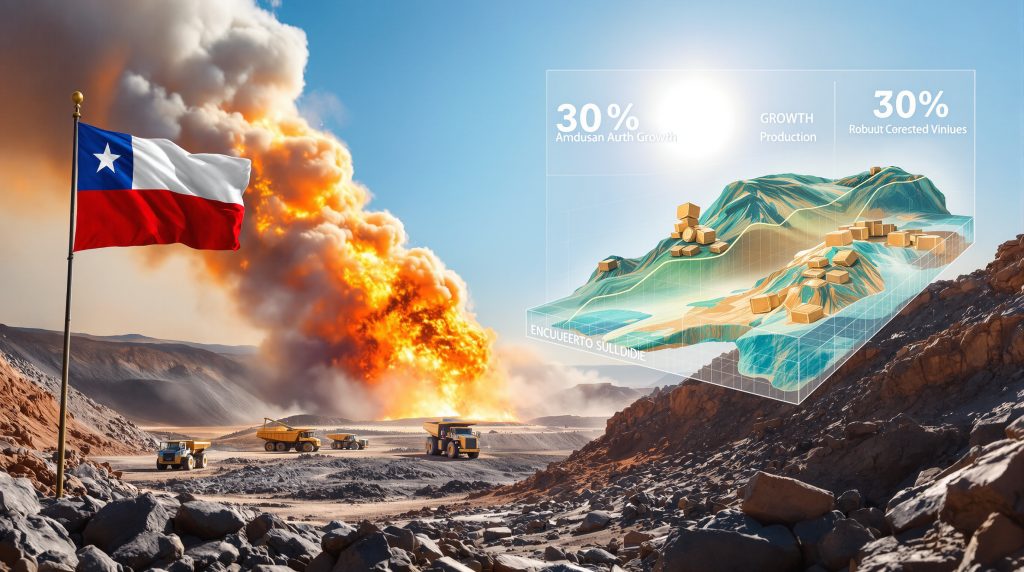Milestone Achievement: First Blast at Encuentro Sulphides Pit Marks Major Copper Expansion
The initial blast at Antofagasta's Encuentro Sulphides pit represents a transformative moment for Chile's copper industry, setting in motion a strategic expansion that will substantially increase the country's copper production capacity. This development comes at a critical time when global copper supply forecast continues to be scrutinized as worldwide electrification efforts and renewable energy transitions drive demand.
Understanding the Significance of the First Blast
The inaugural blast at Encuentro Sulphides isn't merely a routine mining operation—it signals the commencement of comprehensive pre-stripping activities that will ultimately expose valuable sulphide ore resources. This milestone event establishes the groundwork for a production pipeline that will significantly enhance Centinela's output capabilities over the coming years.
Pre-stripping operations involve the systematic removal of overburden material to access the mineral-rich deposits below. The scale of this undertaking at Encuentro Sulphides is substantial, with plans to move approximately 186 million tonnes of material over a two-year timeframe before reaching the high-grade ore body.
Industry analysts note that successful pre-stripping operations are crucial for establishing efficient mining sequences and ensuring steady ore feed once production begins. The careful planning evident in this first blast demonstrates Antofagasta's commitment to operational excellence and strategic long-term development.
Estrategic Integration Within Antofagasta's Growth Vision
The Encuentro Sulphides project represents a cornerstone in Antofagasta's comprehensive growth strategy, which aims to increase the company's total copper production by approximately 30% in the medium term. This expansion aligns perfectly with projections of rising copper demand driven by global electrification trends.
Investment Scale and Production Enhancement
With an approved investment of $1 billion as of July 2025, the Encuentro Sulphides project demonstrates Antofagasta's confidence in copper's long-term market fundamentals. The stripping phase is scheduled for completion by 2028, after which Encuentro will become the primary ore source for Centinela's Second Concentrator facility.
The financial commitment is substantial but strategically sound given copper price insights and its essential role in renewable energy infrastructure. Each ton of copper utilized in renewable energy systems helps displace between 500 and 5,000 tons of CO2 emissions annually, according to industry studies. This relationship between copper and emissions reduction underscores the metal's importance in global sustainability efforts.
Resource Quality and Strategic Value
The Encuentro Sulphides deposit contains approximately 738 million tonnes of ore with an average grade of 0.45% copper, alongside valuable by-products including 0.17 g/t gold and 0.015% molybdenum. This grade compares favorably to Centinela's broader sulphide reserve grade of 0.41% copper, highlighting the deposit's superior quality.
Mining industry specialists recognize that the presence of gold and molybdenum as by-products significantly enhances the economic viability of the project. These additional metals provide important revenue streams that can help buffer against copper price volatility. The molybdenum content is particularly valuable, as this metal is essential for producing high-strength steel alloys used in construction and manufacturing.
The deposit's 0.45% copper grade, while modest by historical standards, represents an economically viable concentration in today's market environment where easily accessible high-grade deposits have become increasingly rare. Modern processing technologies will enable efficient extraction of these resources.
Second Concentrator: Expanding Processing Capabilities
The development of the Encuentro Sulphides pit is integrally connected to the construction of Centinela's Second Concentrator, which will substantially increase the operation's processing capacity and technological capabilities.
Advanced Processing Technology
Once operational, the Second Concentrator will add 95,000 tonnes per day (t/d) of processing capacity to Centinela's operations. This facility will incorporate cutting-edge technologies designed to maximize efficiency and recovery rates.
Among the key technological innovations is the implementation of high-pressure grinding rolls (HPGR), which represent a significant advancement over conventional grinding methods. HPGR technology typically reduces energy consumption by 15-20% compared to traditional grinding circuits while potentially improving mineral liberation and recovery. The energy efficiency gains translate to both cost savings and reduced carbon emissions per ton of copper produced.
The concentrator will also employ advanced flotation technologies and automated process control systems that optimize mineral recovery through real-time adjustments based on ore characteristics. These mining technology innovations reflect the industry's movement toward more efficient and environmentally sustainable processing methods.
Production Projections and Economic Impact
The Second Concentrator is projected to deliver impressive production figures during its first decade of operation:
- Approximately 144,000 tonnes of copper annually
- Around 130,000 ounces of gold annually
- Approximately 3,500 tonnes of molybdenum annually
Combined, these outputs represent an average annual production of 170,000 tonnes of copper-equivalent, making the Second Concentrator a significant contributor to Chile's mineral exports. At current metal prices, this production would generate substantial annual revenue and contribute meaningfully to local economic development.
The economic multiplier effect of mining operations typically results in 2-4 additional jobs created in the broader economy for each direct mining position. This expansion will therefore generate significant employment opportunities in Chile's Antofagasta region, which has historically relied heavily on the mining sector.
Infrastructure Developments Supporting Expansion
A mining operation of this scale requires comprehensive infrastructure upgrades to ensure reliable and efficient operations. The Second Concentrator project includes substantial investments in supporting infrastructure that will enhance operational resilience.
Water Management Systems
One of the most significant infrastructure components is the upgrade to Centinela's raw seawater pumping system. Operating in Chile's arid Atacama region, where freshwater is scarce and often contested, Antofagasta has prioritized seawater use as a sustainable water source.
The upgraded seawater system will transport water from desalination facilities on the coast to the mining operations located at higher elevations inland. This approach represents industry best practice in regions facing water scarcity and helps reduce competition for limited freshwater resources that are vital for local communities and agriculture.
While desalination and pumping seawater require significant energy, these processes ultimately reduce pressure on fragile desert ecosystems and demonstrate responsible resource management. The company's investment in seawater infrastructure aligns with growing expectations for sustainable mining practices.
Tailings Management Facilities
The expansion includes new tailings storage facilities designed to safely contain the increased volume of processed material. Modern tailings facilities incorporate sophisticated engineering features such as:
- Robust geotechnical designs to ensure structural stability
- Comprehensive monitoring systems for early detection of potential issues
- Water recovery systems to maximize recycling
- Dust suppression measures to protect air quality
These facilities represent a critical component of responsible mining operations and are subject to stringent regulatory oversight. The design and operation of tailings facilities have received increased attention within the mining industry following high-profile failures at other operations globally.
Logistics and Energy Infrastructure
Enhanced logistics for energy supply and concentrate transport will complete the infrastructure package. Reliable energy is particularly crucial for continuous processing operations, and the expansion will likely incorporate redundancy measures to prevent costly downtime.
The transport infrastructure for copper concentrate will ensure efficient movement of the final product to port facilities for export to global markets. This logistics chain typically involves specialized vehicles and handling equipment designed to safely transport the valuable concentrate while minimizing environmental impacts.
Pre-Stripping Implementation and Timeline
The pre-stripping phase represents a significant undertaking that will establish the foundation for efficient ore extraction over the life of the Encuentro Sulphides pit.
Material Movement Strategy
During the pre-stripping phase, approximately 186 million tonnes of material will be moved over a two-year period. This massive earthmoving operation requires precise planning and execution to create safe and stable pit walls while efficiently exposing the valuable ore body.
The stripping ratio—the amount of waste material that must be removed to access each unit of ore—is a critical factor in open-pit mine economics. While specific figures for Encuentro Sulphides haven't been published, typical copper porphyry deposits often have stripping ratios between 2:1 and 4:1. The careful sequencing of material removal helps optimize this ratio and improve project economics.
Industry experts note that effective pre-stripping operations establish bench configurations that facilitate efficient drilling, blasting, and loading sequences once production mining begins. These initial development stages therefore have outsized importance in determining the long-term productivity of the operation.
Autonomous Mining Implementation
The project will progressively introduce autonomous mining equipment, building on Centinela's successful deployment of autonomous haul trucks at its Esperanza Sur operation. Full autonomy is targeted from January 2026, representing a significant advancement in mining technology implementation in Chile.
Autonomous haulage systems (AHS) typically deliver several operational benefits:
- Safety improvements by removing operators from hazardous environments
- Productivity increases of 15-20% through optimized routing and continuous operation
- Reduced maintenance costs due to consistent operation patterns
- Decreased fuel consumption and emissions through optimized acceleration and braking
The transition to autonomous operations requires substantial investment in infrastructure, including high-precision GPS systems, comprehensive wireless networks, and sophisticated fleet management software. This technological shift also necessitates workforce training programs to develop the skills needed to monitor and maintain automated systems.
Operational Synergies and Integration
The Encuentro Sulphides project has been designed to maximize synergies with existing infrastructure and operations at Centinela, creating an integrated mining complex with optimized resource utilization.
Strategic Ore Blending
The Encuentro Sulphides pit is strategically positioned to complement Centinela's existing operations. Sulphide ore from Encuentro will feed the Second Concentrator alongside ore from the existing Esperanza Sur pit, creating opportunities for ore blending that can optimize metallurgical performance.
Blending ores from different sources allows operators to maintain more consistent feed characteristics to the concentrator, which improves processing efficiency and recovery rates. The slightly higher grade of the Encuentro material (0.45% copper versus 0.41% for the broader reserve base) provides flexibility in maintaining target head grades over time.
Metallurgists recognize that beyond simple grade considerations, different ore sources often have varying mineralogical characteristics that affect grinding requirements, flotation response, and concentrate quality. A well-designed blending strategy accounts for these factors to maximize value recovery.
Life-of-Mine Planning Integration
The development of Encuentro Sulphides represents a natural progression in the mine's lifecycle, transitioning from depleting oxide resources to the more abundant sulphide reserves beneath. This transition ensures continued productive use of the site and associated infrastructure.
The oxide-to-sulphide transition is common in copper porphyry deposits, where near-surface oxide materials are typically mined first using heap leaching methods before deeper sulphide materials are accessed for concentration. This approach maximizes resource recovery and extends the productive life of mining operations.
By developing Encuentro Sulphides as existing reserves deplete, Antofagasta maintains operational continuity while leveraging existing knowledge of the deposit's geology and characteristics. This approach reduces development risk and helps ensure smooth operational transitions.
Environmental Sustainability Considerations
Modern mining developments must incorporate robust environmental management systems, and the Encuentro Sulphides project includes several features designed to minimize ecological impacts while maximizing resource efficiency.
Water Conservation and Management
The expansion includes significant investments in seawater infrastructure, reducing reliance on scarce freshwater resources in Chile's arid Antofagasta region. This approach aligns with industry best practices for sustainable water management in mining operations.
Chile's copper industry has been a global leader in adopting seawater for mining processes, with approximately 30% of water used in Chilean copper mining now coming from seawater sources. This transition has been driven by both water scarcity concerns and community relations considerations, as mining operations often compete with agriculture and municipal uses for limited freshwater supplies.
While desalination and pumping represent significant energy costs, the use of seawater creates a sustainable water supply that doesn't deplete critical groundwater resources. Modern desalination technologies have become increasingly efficient, reducing both energy requirements and operational costs.
Energy Efficiency Improvements
The incorporation of high-pressure grinding rolls and other modern processing technologies in the Second Concentrator is expected to improve energy efficiency compared to conventional processing methods. These improvements potentially reduce the carbon footprint per tonne of copper produced.
Energy typically represents 15-40% of operating costs in copper mining, making efficiency improvements a priority for both economic and environmental reasons. HPGR technology can reduce specific energy consumption in grinding circuits, which often account for the largest share of a concentrator's energy demand.
Additional energy efficiency measures likely include:
- Variable frequency drives on pumps and motors
- Heat recovery systems
- Energy management software and monitoring
- High-efficiency motors and equipment
The mining industry globally is increasingly focused on reducing carbon intensity, with several major producers setting ambitious emissions reduction targets. Technological improvements like those incorporated in the Second Concentrator represent important steps toward these goals.
Future Implications for Copper Supply
The development of Encuentro Sulphides comes at a critical time for global copper markets, with analysts projecting potential supply deficits as electrification drives increased demand.
Meeting Electrification Demand
The International Energy Agency estimates that achieving global net-zero emissions by 2050 would require quadrupling copper demand for clean energy technologies by 2040. Major sources of growth include:
- Electric vehicles (requiring 4-5 times more copper than conventional vehicles)
- Renewable energy generation (particularly wind power)
- Expanded electrical grids and storage systems
- Charging infrastructure
Against this backdrop of accelerating demand, the development of major copper resources like Encuentro Sulphides takes on strategic importance. The project's expected annual production of 144,000 tonnes of copper would be sufficient to manufacture approximately 4.8 million electric vehicles, based on average copper content of 30kg per vehicle.
Chilean Copper Competitiveness
Chile has historically been the world's largest copper producer, but has faced challenges including declining ore grades, water scarcity, and increasing production costs. The Encuentro Sulphides project demonstrates that with appropriate investment and technology, Chilean copper can remain globally competitive.
The project's integration of advanced technologies like autonomous haulage and efficient processing equipment helps offset the challenges of moderating ore grades. These investments position Centinela to maintain cost-effective production even as the industry evolves.
Chile's stable mining framework, experienced workforce, and established infrastructure provide advantages that continue to attract major investment despite emerging competition from copper projects in other regions like Africa and Central Asia.
Conclusion: Long-term Impact on Global Copper Supply
The first blast at Encuentro Sulphides pit marks the beginning of a transformative expansion for Centinela and Antofagasta. By leveraging modern mining technologies, optimizing infrastructure, and developing high-grade ore resources, the company is positioning itself for sustainable growth in copper production at a time when global demand for the metal continues to rise due to energy transition and electrification trends.
This strategic development reinforces Antofagasta's position as a major player in global copper production, with Centinela set to become an increasingly important contributor to the company's overall output in the years ahead. The project exemplifies how traditional mining regions can adapt to changing market conditions through technological innovation and strategic investment.
As the global energy transition accelerates, projects like Encuentro Sulphides will be essential in ensuring adequate copper supplies to support renewable energy deployment, electric vehicle manufacturing, and grid modernization. The successful execution of this expansion will therefore have implications extending far beyond Chile's mining sector.
Disclaimer: This article contains forecasts and projections about future production and market conditions. These statements are based on current information and assumptions that may change due to various factors including market conditions, regulatory changes, and operational developments. Readers should not interpret these projections as guaranteed outcomes.
Want to Capitalise on Major Mineral Discoveries Like This?
Discover the next potentially transformative mineral announcement before the market does with Discovery Alert's real-time notifications powered by its proprietary Discovery IQ model. Visit our discoveries page to understand how major mineral discoveries have historically yielded exceptional returns for early investors.




